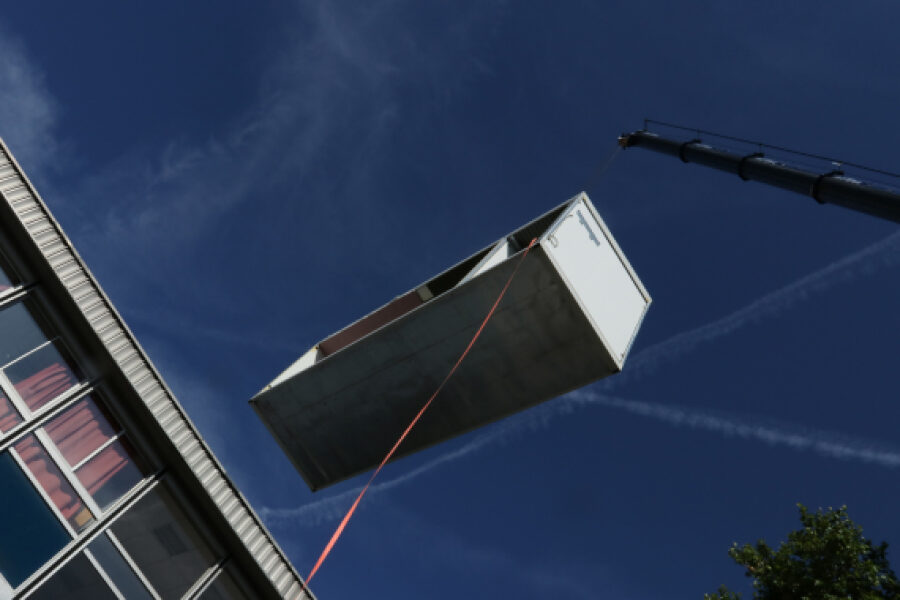How Airports Can Benefit From Modular Design & Construction

Airport operators are faced with many concerns when tasked with developing solutions to meet current and proposed facility space requirements. Understanding how to expand capacity quickly to meet traveler demand, ensuring that operations continue running smoothly, and maintaining a good passenger experience are paramount.
Modular or prefabricated construction could be a great way to improve construction efficiency, keep costs down, and reduce airfield movement impacts. Prefabrication and modular design are similar, however there is a difference. While all modular construction is inherently prefabricated, all prefabrication construction is not modular. Modules of prefabricated “box-like” components can result in the building structure when assembled. It is the prefabrication component of these construction methods that make them well suited for the airport environment.
During construction, closing any part of an airport for a project is not feasible. Lessening the number of cranes and other construction traffic on operating airfields is a significant contributor to speed, safety, and operational continuity. The efficiency of prefabrication and modularization makes it a great option to ease airport stress. It also helps keep the airport as close to fully operable as possible and able to quickly address growing capacity needs.
When to Consider Modularization
Modularity is best suited for repetitive components that can be constructed mostly offsite, then transported on-site and assembled like building blocks. When considering whether modular design and construction is right for your airport, it is best to first look at the purpose your space is going to serve.
Is your airport looking for a temporary solution to address capacity needs during a renovation? Or are you looking for a permanent solution to quickly expand a terminal or concourse? In either situation, there are benefits to modular design and construction.
As a Temporary Solution
For a temporary space, modular solutions are cost-effective and can meet space needs quickly, especially if an airport is reaching capacity and needs a fast solution. If required, it can be repurposed or reused as part of another project. During renovations of terminals or concourses, temporary spaces can also serve as an alternative to closing operations during construction, allowing your airport to continue operating at full or near capacity.
As a Permanent Solution
As is often the case at airports, temporary solutions can turn into permanent solutions. Recognizing and anticipating that possibility makes modular design and construction a great solution.
For example, let’s consider a separate stand-alone concourse structure to fulfill a gate shortage. The primary public area elements of this building could include departure lounges, concessions, restrooms, and circulation space. Each of these types of spaces could be further divided into standard sized three-dimensional modules that, when all assembled, form the building. Complete restroom modules – built almost entirely offsite – would be trucked in and lifted into place. Similarly, each of the other types would be modularly fabricated and connected to one another. The overall efficiency comes from the concurrent prefabrication of modules, staging them near the building site, thus allowing for rapid assembly.
Modular design and construction results in condensing crane time, shortening overall assembly time, and reducing construction personnel while working on the airfield. The benefit of this is that your airport can deliver a facility expansion sooner. In some cases, modular construction can be completed up to 50 percent faster than traditional methods. This speed to market means these facilities are up and operating quicker, improving the passenger experience (by limiting construction disruption), elevating the airport’s level of service, and generating additional revenue.
The Benefits of Modular Design & Construction
Airports can benefit from design and construction modularization for both temporary and permanent solutions. Speed of delivery, reduced labor cost, and minimized operational impacts are just some of the reasons that it might be a reasonable solution for your airport.
Modular is Not a Four-Letter Word
“Modular” does not need to mean drab and boring. It does not need to suggest bolting together several shipping containers complete with windows to form a departure lounge. A modular facility is transparent to the passenger, providing an equal or better level of service. Finishes, circulation, operational efficiency all can perform and outperform traditional construction methods. Landside, airside, ticketing, check-in, baggage claim, concourse, departure lounges, or FIS facility, modular construction can provide superior passenger services for far less cost and bring the facility online sooner.
Success with modular design and construction comes from proper space planning, understanding how module size and configuration may impact both passenger movement and aircraft placement, and clearly defining assembly logistics to minimize operational impacts. A primary benefit, beyond cost and schedule, is the ability to construct components in a more controlled environment, that is offsite. Focused element assembly is in a warehouse setting or a non-operational airport setting. This construction method stops impacts due to weather, eliminates suspension of work due to aircraft operations, and reduces multiple trades potentially obstructing one another, all while improving the finished product’s cleanliness.
Ease of Constructability & Mobility
Offsite assembly and construction of modular building components allow site-related activities to progress concurrently. Due to the nature of the structure, mobility is easy. After building elements are constructed, assembled sections of the building can be moved and placed seamlessly in the final location at low traffic times, limiting disruptions to operations and flight schedules.
Collaboration Between Designer & Contractor
The airport, the designer, and the contractor must work closely through the entire modular design and construction process to ensure that the facility is efficient, easily prefabricated, and transportable. This collaboration helps the project stay on schedule and limits disruption to airport operations.
Overall, modular design and construction is an excellent approach to an airport expansion project. This application can save airports time and money and help reach expansion goals quicker, with limited disruption to operations.
Reach out to our aviation experts to learn how to implement this solution for your next project to ensure your airport remains operational and efficient.




